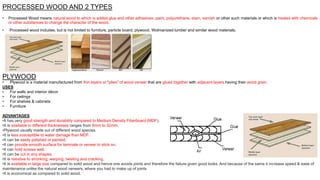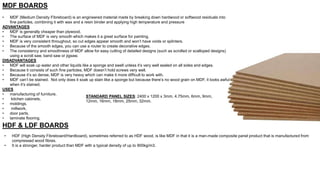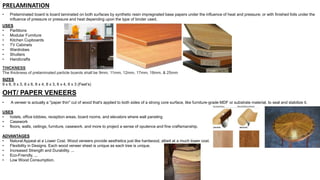WOOD AS A INTERIOR MATERIAL.pptx
- 2. ŌĆó PROCESSED WOOD AND 2 TYPES ŌĆó PLY ŌĆó BLOCK BOARD ŌĆó PARTICAL BOARD ŌĆó MDF BOARD ŌĆó HDF/LDF BOARD ŌĆó SURFACE TREATMENT OF WOODS AND TYPES ŌĆó LAMINATE ŌĆó PRELAMINATION ŌĆó OHT/ PAPER VENEERS WOOD AS INTERIOR MATERIAL, USAGE, ADVANTAGES OF EACH TYPE, USES, PROS, CORNS
- 3. PROCESSED WOOD AND 2 TYPES ŌĆó Processed Wood means natural wood to which is added glue and other adhesives, paint, polyurethane, stain, varnish or other such materials or which is treated with chemicals or other substances to change the character of the wood. ŌĆó Processed wood includes, but is not limited to furniture, particle board, plywood, Wolmanized lumber and similar wood materials. PLYWOOD ŌĆó Plywood is a material manufactured from thin layers or "plies" of wood veneer that are glued together with adjacent layers having their wood grain. USES ŌĆó For walls and interior d├®cor ŌĆó For ceilings ŌĆó For shelves & cabinets ŌĆó Furniture ADVANTAGES ŌĆóIt has very good strength and durability compared to Medium Density Fiberboard (MDF). ŌĆóIt is available in different thicknesses ranges from 6mm to 32mm. ŌĆóPlywood usually made out of different wood species. ŌĆóIt is less susceptible to water damage than MDF. ŌĆóIt can be easily polished or painted. ŌĆóIt can provide smooth surface for laminate or veneer to stick on. ŌĆóIt can hold screws well. ŌĆóIt can be cut in any shapes. ŌĆóIt is resistive to shrinking, warping, twisting and cracking. ŌĆóIt is available in large size compared to solid wood and hence one avoids joints and therefore the failure given good looks. And because of the same it increase speed & ease of maintenance unlike the natural wood veneers, where you had to make up of joints ŌĆóIt is economical as compared to solid wood.
- 4. DISADVANTAGES ŌĆó It is more expensive than Medium Density Fiberboard (MDF). ŌĆó Because the layers of veneers are seen at the edges, edges have to be finished either with laminate or veneer. ŌĆó It often get splinter from the edges during transportation. ŌĆó It is quite difficult to cut. ŌĆó It is known to emit toxic VOCŌĆÖs (Volatile Organic Compound) as it can irritates in eye. ŌĆó Water may damage Moisture Resistant (MR) grade plywood. ŌĆó For common people, it is difficult to judge which wood veneer has been used for making the plywood. ŌĆó It is costlier as compared to blockboard or particleboard. ŌĆó The most of the commercial grade plywood needs to be covered by laminates. Sunmica, so as to enhance its beauty and to increase its life. It is prone to termite effect and may get damaged once affected. BRANDS IN INDIA ŌĆó Globe Panel Industries ŌĆó Ply News ŌĆó Century Ply ŌĆó National Plywood Industries ŌĆó Green Ply ŌĆó Kitply Plywood ŌĆó Kridha Plywood & Laminates ŌĆó Northern Ply ŌĆó Sharen Ply ŌĆó Merino Laminates BLOCK BOARD Blockboard consists of a core made of wooden strips or blocks, placed edge to edge between two layers of plywood, which are then glued together under high pressure. USES ŌĆóFor making tables, benches, and wall furniture ŌĆóUsed for blockboard doors and solid core flush doors ŌĆóFor creating single and double beds and settees ŌĆóFor making beautiful wall panels and partitions ŌĆóFor woodwork in railway carriages ŌĆóFor interior and exterior decoration ŌĆóIt is also used in making study shelves, window shelves, etc
- 5. ADVANTAGES 1.lighter in weight 2.Block boards cost less 3.Because the interior is solid wood strip, it is convenient for on-site construction. 4.Block boards have more strength and durability & moisture resistance. 5.Compare with MDF and particle board, block board use less glue, 6.Block board has a strong vertical bearing capacity. DISADVANTAGES 1.Block boards are not as strong as plywood or good quality solid wood, Block boards are lighter in weight as it is made by using softwood strips. 2.Screwing and nailing must be done carefully. If small gaps are left inside the core, then block boards may be difficult to handle. 3.If nails are punched in the gap, there is basically no nail holding force. This may affect the strength and durability of the furniture. 4.Block board has poor load-bearing bending strength. The solid wood strip inside the block board is longitudinally spliced, so the vertical bending resistance is poor, and the long-term force will cause obvious lateral deformation of the board. 5.Block board should not be used directly in a humid kitchen environment. AVAILABLE SIZES AVAILABLE THICKNESS
- 6. PARTICLE BOARD ŌĆó Particle board, also known as chipboard or low-density fiberboard, is an engineered wood product manufactured from wood chips and a synthetic resin or other suitable binder, which is pressed and extruded. ŌĆó Particle board is often confused with oriented strand board (OSB) (also known as flakeboard, or waferboard) USES ŌĆó particleboard is used as a flooring material in temporary structures . ŌĆó They serve as a base for parquet, wood, and carpeted floors. ŌĆó Because it is non-load bearing and has good thermal and acoustic insulation properties, particleboard is a great choice for partition walls. ŌĆó Because of their thermo-acoustic insulation properties, laminated particle boards, and cement particle boards are commonly used in false ceilings. ŌĆó Beds, storage units, shoe racks, TV cabinets, and small shelves can all be made out of plain particleboard. ŌĆó Televisions, speaker boxes, sewing machine tops, and vehicle parts all are manufactured by using particle boards, particularly wood veneer particle boards. SIZES AND THICKNESS ŌĆó The most common board sizes are 600 x 2400 mm and 1200 x 2400 mm thickness of 22 mm. ADVANTAGE ŌĆócost-effective option against plywood or MDF. ŌĆóIt does not dent or distort easily. ŌĆóParticle board has more screw holding capacity as compared to MDF, so it is widely used to make furniture which can be assembled using screws. ŌĆóminimal maintenance and is easy to clean. ŌĆóParticle boards have thermo-acoustic insulation properties, so they are very much useful in speakers and in false ceiling of auditoriums, theaters, etc. ŌĆóIt is an eco-friendly material as it uses wood waste such as wood chips, sawdust, wooden shavings, and bagasse which is residue of sugarcane after the juice is extracted. DISADVANTAGE ŌĆó Particle board has low strength ŌĆó It has low density ŌĆó In presence of moisture, particle board expands and warps. Also in extreme conditions discoloration can occur. ŌĆó It cannot support heavy loads as it is weak in strength.
- 7. MDF BOARDS ŌĆó MDF (Medium Density Fibreboard) is an engineered material made by breaking down hardwood or softwood residuals into fine particles, combining it with wax and a resin binder and applying high temperature and pressure ADVANTAGES ŌĆó MDF is generally cheaper than plywood. ŌĆó The surface of MDF is very smooth which makes it a great surface for painting. ŌĆó MDF is very consistent throughout, so cut edges appear smooth and wonŌĆÖt have voids or splinters. ŌĆó Because of the smooth edges, you can use a router to create decorative edges. ŌĆó The consistency and smoothness of MDF allow for easy cutting of detailed designs (such as scrolled or scalloped designs) using a scroll saw, band saw or jigsaw. DISADVANTAGES ŌĆó MDF will soak up water and other liquids like a sponge and swell unless itŌĆÖs very well sealed on all sides and edges. ŌĆó Because it consists of such fine particles, MDF doesnŌĆÖt hold screws very well. ŌĆó Because itŌĆÖs so dense, MDF is very heavy which can make it more difficult to work with. ŌĆó MDF canŌĆÖt be stained. Not only does it soak up stain like a sponge but because thereŌĆÖs no wood grain on MDF, it looks awful when itŌĆÖs stained. USES ŌĆó manufacturing of furniture, ŌĆó kitchen cabinets, ŌĆó moldings, ŌĆó millwork, ŌĆó door parts, ŌĆó laminate flooring. STANDARD PANEL SIZES: 2400 x 1200 x 3mm, 4.75mm, 6mm, 9mm, 12mm, 16mm, 18mm, 25mm, 32mm. HDF & LDF BOARDS ŌĆó HDF (High Density Fibreboard/Hardboard), sometimes referred to as HDF wood, is like MDF in that it is a man-made composite panel product that is manufactured from compressed wood fibres. ŌĆó It is a stronger, harder product than MDF with a typical density of up to 900kg/m3.
- 8. ADVANTAGES DISADVANTAGES ŌĆó Hardboard is durable & impact resistant Hardboard itself is not waterproof ŌĆó Moisture resistant No natural wood grain aesthetic ŌĆó Relatively low cost compared to plywood Not as strong as plywood THICKNESS ŌĆó Typical thickness of 3mm-8mm SURFACE TREATMENT OF WOODS AND TYPES ŌĆó Wood surfaces are pre-treated and coated for decorative purposes or to increase durability. ŌĆó When formulating primers, glazes and varnishes, knowledge of the surface chemical properties of these materials and of the different types of wood is very helpful. Surface treatment Max. dimensions of parts (mm) Hard anodizing 1850 x 850 x 550 Hard black anodizing 1850 x 850 x 550 Natural anodizing 1850 x 850 x 550 Natural black anodizing 1850 x 850 x 550 Anodizing in chromic acid 1850 x 850 x 550
- 9. LAMINATE ŌĆó Laminate sheets can be used to enhance the appeal of all types of surfaces, including walls and furniture. ŌĆó They not only offer a great way to beautify your spaces, but also provide strength and protection to your property's elements. USES ŌĆó On furniture ŌĆó Shelves ŌĆó Modular cabinets ŌĆó Wall highlights ADVANTAGES 01.It is easy to clean. 02. It is easier to install than many traditional surfaces. 03. It is more economical and requires less skill to install. 04. It is available in numerous designs, patterns, colors and textures and hence it is pleasing. 05. It is very durable, hygienic and relatively easy to maintain. 06. No polishing painting is required. 07. It is the best choice for heavy use environments. 08. It can be installed over almost any existing floor. 09. It is moisture resistant. Also, it is an impact, shock and pressure resistant. 10. Sweeping or vacuuming is typical, all it takes to get laminate clean. 11. It is highly resistant to scratch and abrasion. 12. Availability of huge range leads to least wastage. TYPES ŌĆó Matte-finish laminate ŌĆó Textured laminate ŌĆó Gloss-finish laminate ŌĆó Metallic laminate ŌĆó PVC-finish laminate ŌĆó Acrylic-finish laminate ŌĆó Exterior laminate The laminates are available in thickness 0.8 mm, 1.0 mm and 1.5 mm in standard sizes 1.2 m x 2.5 m DISADVANTAGE 01. While it can follow the look of a veneer, laminate flooring does not come close to the feel of those textures of a veneer. No matter how high in quality, it cannot simulate the feel of real wood under your feet. 02. Once the top layer has been worn through, the whole floor must be replaced. 04. It is difficult to be recycled. 05. It is a brittle material hence is prone to clipping. 06. Laminate flooring has been very slippery, and affecting your safety.
- 10. PRELAMINATION ŌĆó Prelaminated board is board laminated on both surfaces by synthetic resin impregnated base papers under the influence of heat and pressure; or with finished foils under the influence of pressure or pressure and heat depending upon the type of binder used. USES ŌĆó Partitions ŌĆó Modular Furniture ŌĆó Kitchen Cupboards ŌĆó TV Cabinets ŌĆó Wardrobes ŌĆó Shutters ŌĆó Handicrafts THICKNESS The thickness of prelaminated particle boards shall be 9mm, 11mm, 12mm, 17mm, 18mm, & 25mm SIZES 9 x 6, 9 x 3, 8 x 6, 8 x 4, 8 x 3, 6 x 4, 6 x 3 (FeetŌĆÖs) OHT/ PAPER VENEERS ŌĆó A veneer is actually a "paper thin" cut of wood that's applied to both sides of a strong core surface, like furniture-grade MDF or substrate material, to seal and stabilize it. USES ŌĆó hotels, office lobbies, reception areas, board rooms, and elevators where wall paneling ŌĆó Casework ŌĆó floors, walls, ceilings, furniture, casework, and more to project a sense of opulence and fine craftsmanship. ADVANTAGES ŌĆó Natural Appeal at a Lower Cost. Wood veneers provide aesthetics just like hardwood, albeit at a much lower cost. ... ŌĆó Flexibility in Designs. Each wood veneer sheet is unique as each tree is unique. ŌĆó Increased Strength and Durability. ... ŌĆó Eco-Friendly. ... ŌĆó Low Wood Consumption.









